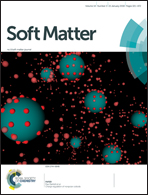Impact of macromolecular crowding on RNA/spermine complex coacervation and oligonucleotide compartmentalization†
Abstract
We report the effect of neutral macromolecular crowders poly(ethylene glycol) (PEG) (8 kDa) and Ficoll (70 kDa) on liquid–liquid phase separation in a polyuridylic acid (polyU)/spermine complex coacervate system. The addition of PEG decreased both the amount of spermine required for phase separation and the coacervation temperature (TC). We interpret these effects on phase behavior as arising due to excluded volume and preferential interactions on both the secondary structure/condensation of spermine-associated polyU molecules and on the association of soluble polyU/spermine polyelectrolyte complexes to form coacervate droplets. Examination of coacervates formed in the presence of fluorescently-labeled PEG or Ficoll crowders indicated that Ficoll is accumulated while PEG is excluded from the coacervate phase, which provides further insight into the differences in phase behavior. Crowding agents impact distribution of a biomolecular solute: partitioning of a fluorescently-labeled U15 RNA oligomer into the polyU/spermine coacervates was increased approximately two-fold by 20 wt% Ficoll 70 kDa and by more than two orders of magnitude by 20 wt% PEG 8 kDa. The volume of the coacervate phase decreased in the presence of crowder relative to a dilute buffer solution. These findings indicate that potential impacts of macromolecular crowding on phase behavior and solute partitioning should be considered in model systems for intracellular membraneless organelles.

- This article is part of the themed collection: Complex Coacervation


 Please wait while we load your content...
Please wait while we load your content...